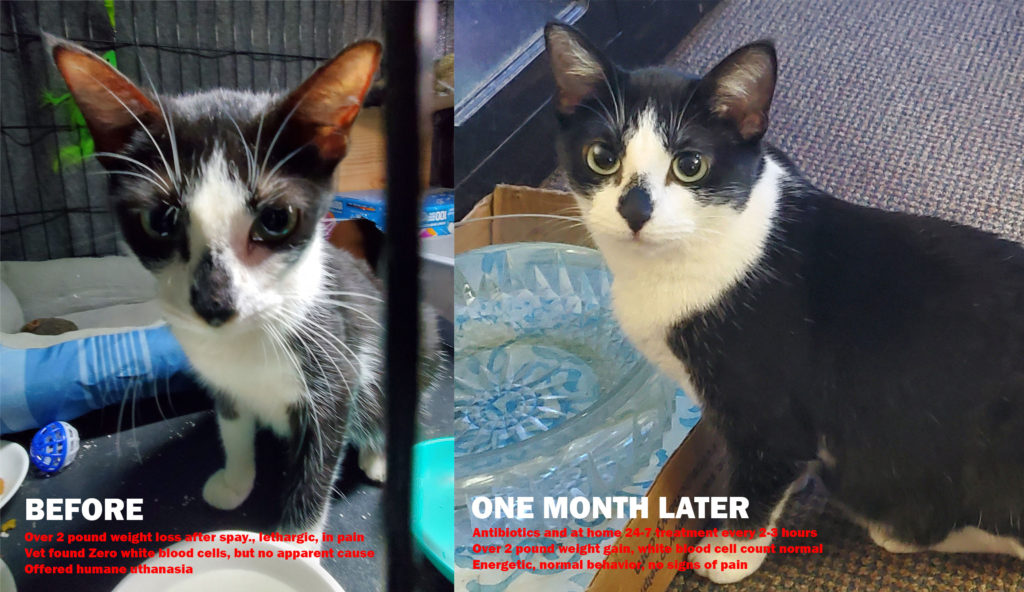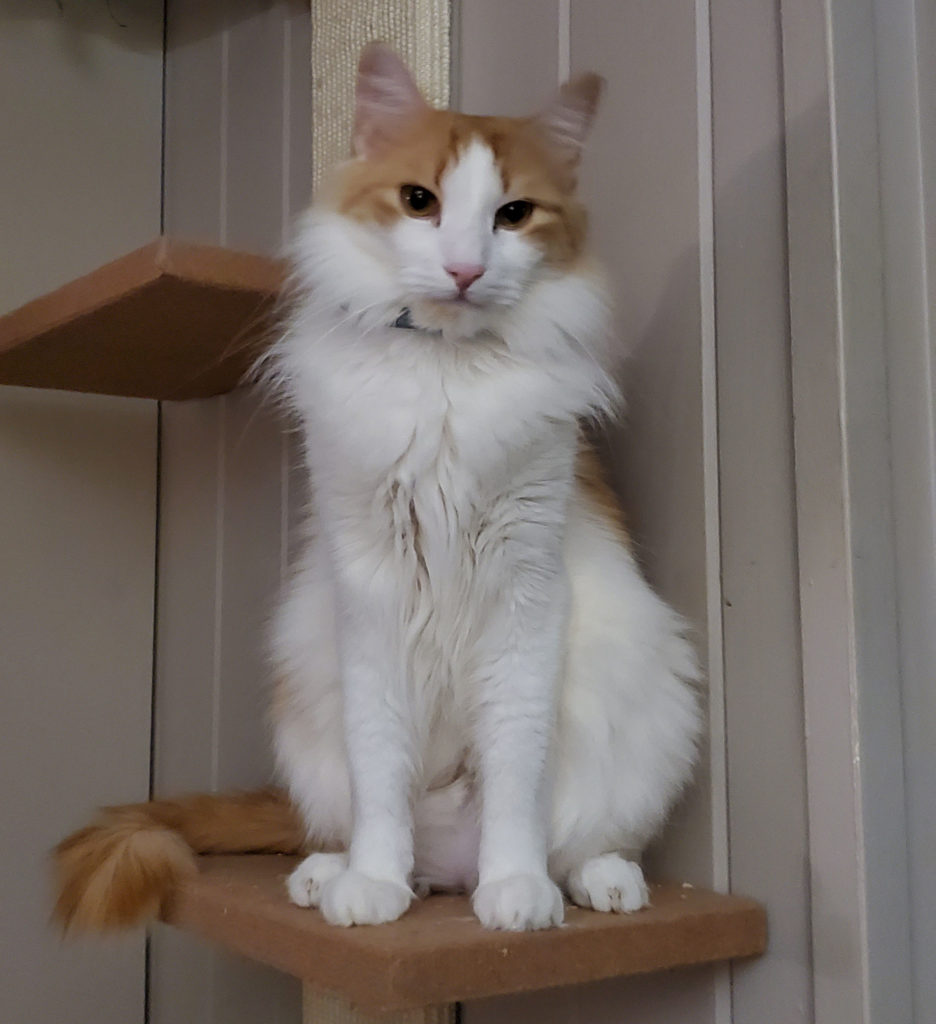Why Has My Cat Quit Eating?
TXCAT ORG | Posted on |

I am not a rescue, just an individual seeking to help hapless cats; however, I have trapped and vetted over 110 cats since 2019 and am still seeking homes for many who are still at The Duncan Home For Wayward Cats awaiting adoption.
This article is not intended to provide medical advice for your pet, rather it is just my suggestions based on my experience with this number of cats.
When Sir Jeffrey Quit Eating
Sir Jeffrey is a male cat who we have had since birth and he is a bit autistic in that he will only eat one type of wet food and nothing else. He will only eat his wet food in one location served exactly the same way daily. He will not even sniff Temptation cat treats that the other cats go nuts for. He does not like to be petted or held.
He was always a very healthy eater until he stopped eating on a Tuesday.
He would still eagerly approach his food like he was hungry and sniff it, then turn away.
After trying a number of common tactics and different foods to get him to eat, nothing worked and it was now a Friday and the 4th day since he had eaten.
Note: Sir Jeffrey is a big, healthy 15-pound boy and I could have opted to syringe feed him while seeking to determine why he quit eating, but I opted to wait a bit longer given his size and because it was unclear if he might have a stomach or intestine issue, in which case forcing food into him might exacerbate things.
In our town, there are no vets open on the weekend and only one ER vet within 3 hours' driving distance. Since he was not eating at all and by Monday would be 6 days since he had eaten which I felt was too long, so rather than waiting until Monday for a local vet visit, I drove him to an ER vet about 30 miles away.
Many tests and seven hundred and fifty ($750) dollars later, we returned home with no insight into why he was refusing to eat.
Back at home, we continued trying to get him to eat throughout the weekend. One time when I was trying to coax him to eat, I leaned down close to him and after he eagerly approached his food and sniffed it, then he very lowly growled at his food before turning away from it.
After witnessing this and hearing him growl at his food, I reasoned that he wanted to eat, but something must be hurting him or something about his food had become painful to him even though the ER vet had found no apparent cause for him refusing to eat.
Monday I took him to a local vet and told them what had transpired.
Upon their inspection of his mouth, an abscessed tooth was discovered that required surgery to remove, and within a couple of days, Sir Jeffrey was back to eating his favorite food normally.
I tell this story because the first vet did not think to check for a gum or tooth issue as the reason for what seemed like appetite loss when it was not, it was a pain issue.
Sir Jeffrey's case illustrates how appetite loss and refusing to eat can be very different issues and require very different treatments.
For example, an appetite stimulant would not have been beneficial to him because his issue was pain, rather than lack of appetite.
The ER vet had focused only on possible stomach or intestine causes while completely overlooking a dental issue that was obvious to another vet. Jeffrey's appetite was ok and he wanted to eat but refused to eat due to pain.
If your cat stops eating normally, the following may warrant consideration and it could be up to you to ask your vet to rule out or confirm these and/or other possible causes.
- Dental (tooth) issue
- Calcivirus
- Gingivitus and Stomatitis
- Other
- FeLV+
- FIP+
The moral of this experience for me is to be open to considering additional possibilities for illness or abnormal behavior, regardless of what a vet may say and/or regardless of what test results may fail to identify.
Please keep this moral in mind as we consider FeLV and FIP as they might be related to a cat refusing to eat.
My second experience with a cat not eating was with Ms. Halley.
- Read her story here

When FeLV+ Josh Started Eating Much Less Than Normal
My third experience with a cat's eating behavior changing drastically for unknown reasons happened with Josh, a shorthair male who weighed 8.6 pounds and was 9 months old when a friend brought him to us. You can read Josh's origin story here.
On April 6, 2022, when he went for neuter surgery and tested FeLV+ I was so sad for this special young cat just starting his life. I endeavored to learn all I could about FeLV, tests that detect it, therapies for it, treatments for it, and other FeLV pet owner experiences with it.
Ultimately, I chose to treat Josh with Retromad1 and evaluate his viral load via IDEXX FeLV tests as his treatment progressed.
- FeLV Antigen by ELISA (709) with
- FeLV Quant RealPCR™ Test (26354)
- Both Tests Combined (26355)
Includes quantification of FeLV viral particles if PCR positive
On May 12th, 2022 Josh's first FeLV PCR test results indicated a viral load of 47.86 before any treatment began.
On June 10th,2022, I began dosing Josh twice daily and planned to have another FeLV Quant PCR test done in 30 days, even though the Retromad1 rep indicated 90 days.
Unfortunately, during the first 30 days, my schedule did not permit me to dose him with Retromad1 three times a day (every 8 hours), but only twice daily. (every 12 hours.)
On July 11th, 2022, I had Josh's bloodwork done to evaluate his overall FeLV condition, also because in the last 10 days he had developed a fever of unknown origin, his appetite had diminished significantly and this normally energetic and playful boy was not interested in playtime, and he was sleeping significantly more than normal. Very significant changes in only 10 days.
Josh's 2nd Quant PCR test was done at the same time and indicated a viral load of 63.52, so, unfortunately, 30 days of Retromad1 had not prevented his FeLV viral load from increasing.
The vet did not discuss anything about his bloodwork and blood chemistry that concerned them.
That night I posted Josh's bloodwork in a Facebook FeLV cat owner's group for comments because I wanted opinions about his status and why he had a fever and was not eating normally, etc.
Within minutes of posting his bloodwork, group members responded that his bloodwork contained markers for FIP and that I should ask the vet to do an ultrasound to check for fluid accumulation.
My first thought was, “What the hell is FIP?, Josh has FeLV”. Of course, I immediately consulted the great oracle Google and spent the rest of the evening schooling myself about FIP only to find out that it could kill him very quickly (even in days) whereas the FeLV death sentence he already had is typically about 2.5+ years.
Now, this poor boy has two death sentences. The universe must be very determined to kill this sweet cat.
My findings about FIP further indicate that there are three types of FIP with each being worse than the other. FIP is also notoriously difficult to definitively diagnose because it is a cat coronavirus mutation. There has been no single test for conclusively confirming FIP, but recently IDEXX has begun offering their FIP Virus RealPCR test to aid in diagnosing FIP. You may need to specifically request your vet run this test because so many vets are unfamiliar with FIP and how to diagnose it.
To make matters worse, because FIP is uncommon many vets are totally unfamiliar with it and the symptoms it can cause, and with the procedures for diagnosing FIP, so they may fail to consider it as a possible cause of symptoms that they are observing and thus fail to diagnose FIP.
Comment: I submit that there is also the possibility that one reason FIP is regarded as relatively uncommon is that many cases are never diagnosed.
Often, vets run a bunch of tests seeking known causes for symptoms common to FIP, such as:
- reduced appetite
- or refusing to eat
- fever of unknown origin
- lethargy
- trouble walking or jumping
- fluid accumulation in the abdomen
- trouble breathing (fluid accumulation in the chest)
- cloudiness in the eyes
- different sized pupils
- blindness
- diarrhea or constipation of uncertain origin
When these symptoms are present there can be many different causes, but if FIP happens to be the cause, then any delay in beginning FIP treatment can result in unnecessary death for the cat.
Comment: Should FIP treatment be started and the symptoms are not from FIP, there is no harm in administering the drug, so IMHO better safe than sorry when your vet cannot conclusively identify the root cause of symptoms.
In fact, many cats may die needlessly from FIP without the vet or the pet owner ever knowing the actual cause of death even though a drug with a 90% cure rate for FIP (GS-441524) was discovered in 2019 by Dr, Pederson at UC Davis in California.
Unfortunately, as of this writing, GS-441524 can only be obtained through non-traditional channels.
On July 11th, 2022 I took Josh back to the vet and told them what FeLV group members on Facebook had commented about his blood markers and about their suggestion to do an ultrasound to look for fluid accumulation because that symptom is almost unique to FIP. (I am pretty sure the vet did not like Dr. Facebook butting into their realm. Oh well.)
The vet resisted doing the ultrasound saying it was unnecessary and I finally told them, “Just do it so I can quit worrying about that.” They begrudgingly agreed and about 10 minutes later they came back to the exam room with their head hanging down and a syringe full of fluid pulled from Josh's abdomen.
They said they would never have thought that and they have never seen any outcome for FIP except death, so they recommended euthanization right then. I declined and told them I was going to try a FIP treatment, (which the vet had never heard of).
The vet firmly restated that their recommendation was euthanization and I declined again.
On July 15th, 2022 Josh received his first injection of the 84-day treatment. That treatment experience is a whole other story for another article, but for the sake of this story, let's just say it worked! It worked fast and effectively. Amazing. Be advised, it is an expensive treatment.
On August 15th, 2022, (Josh was supposed to be dead by then) The FIP treatment was successfully resolving all his FIP symptoms and I took Josh back to the vet for 30-day bloodwork and another FeLV Quant PCR test. His blood work was much improved; unfortunately, his FeLV viral load had increased to 132.11.
That day, I began dosing Josh every 8 hours with Retromad1 until my supply was depleted on Sept 20, 2022.
On September 20, 2022, I took Josh back to the vet for bloodwork and another FeLV Quant PCR test. His blood work was much improved and his FeLV viral load had DECREASED to 105.18.
I ordered another supply of Retromad1 and will continue treating him every 8 hours when it arrives and report back.
On October 6, 2022, Josh completed his 84-day FIP treatment but I chose to continue his treatment until 10/20 when I will have another blood panel and FeLV Quant PCR test done. That bloodwork will reflect another 30-days of FIP treatment since his last bloodwork and if all is well, then Josh will enter the 84-day observation period.
The moral of this story is that Josh's decreased appetite, fever, and lethargy were caused by something the vets would not even consider (FIP) and even if they do consider FIP, most will only recommend euthanasia rather than treatment. And because the drug is not available for USA vets to legally procure and prescribe, their hands are tied except for referring patients to FIP support groups like FIP Warriors. Some do and some do not.
Essentially, it is up to the pet owner to self-educate and make their own decision about their pet's treatment when faced with unknown causes of symptoms that vets struggle to identify.


Leave a Reply